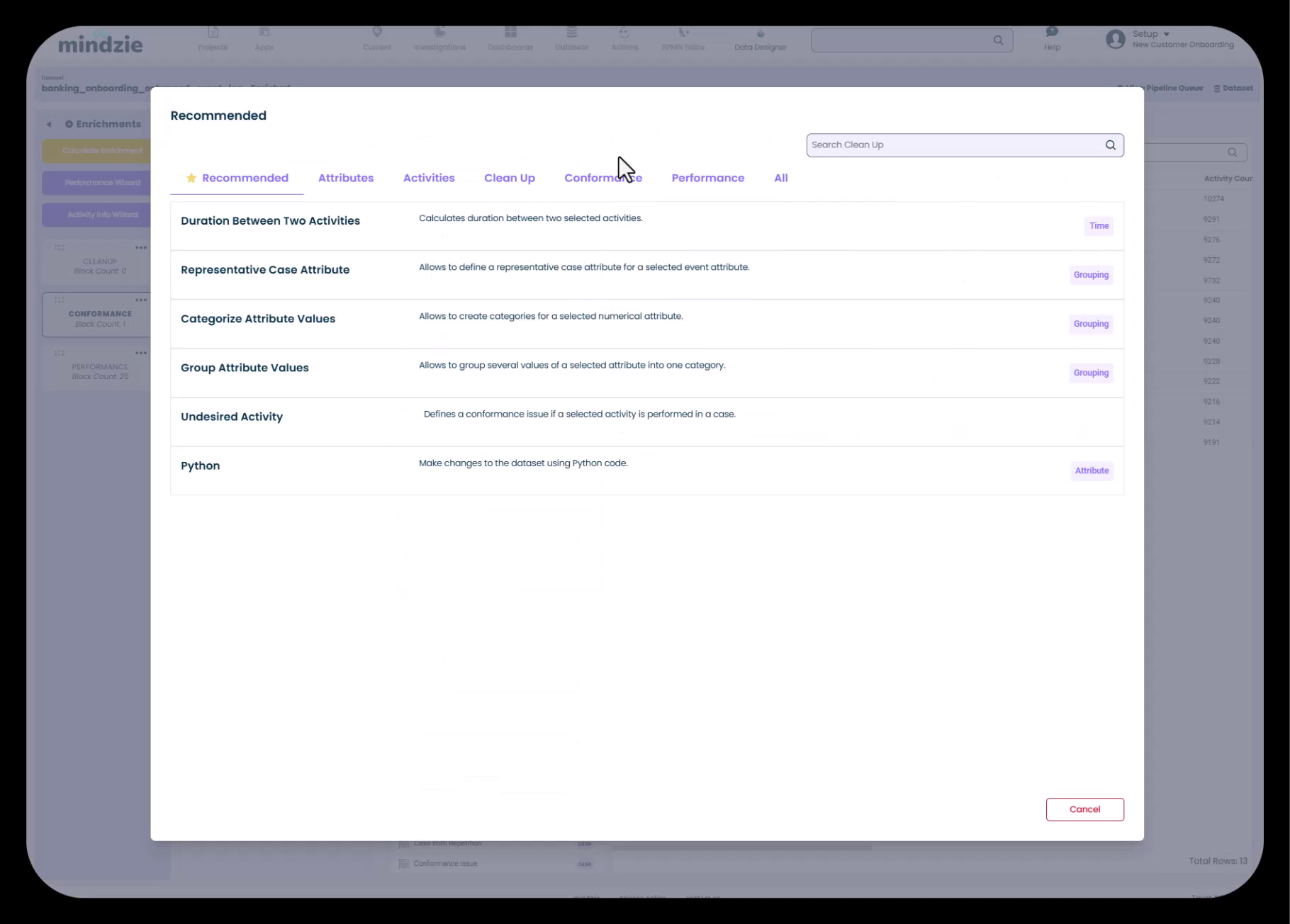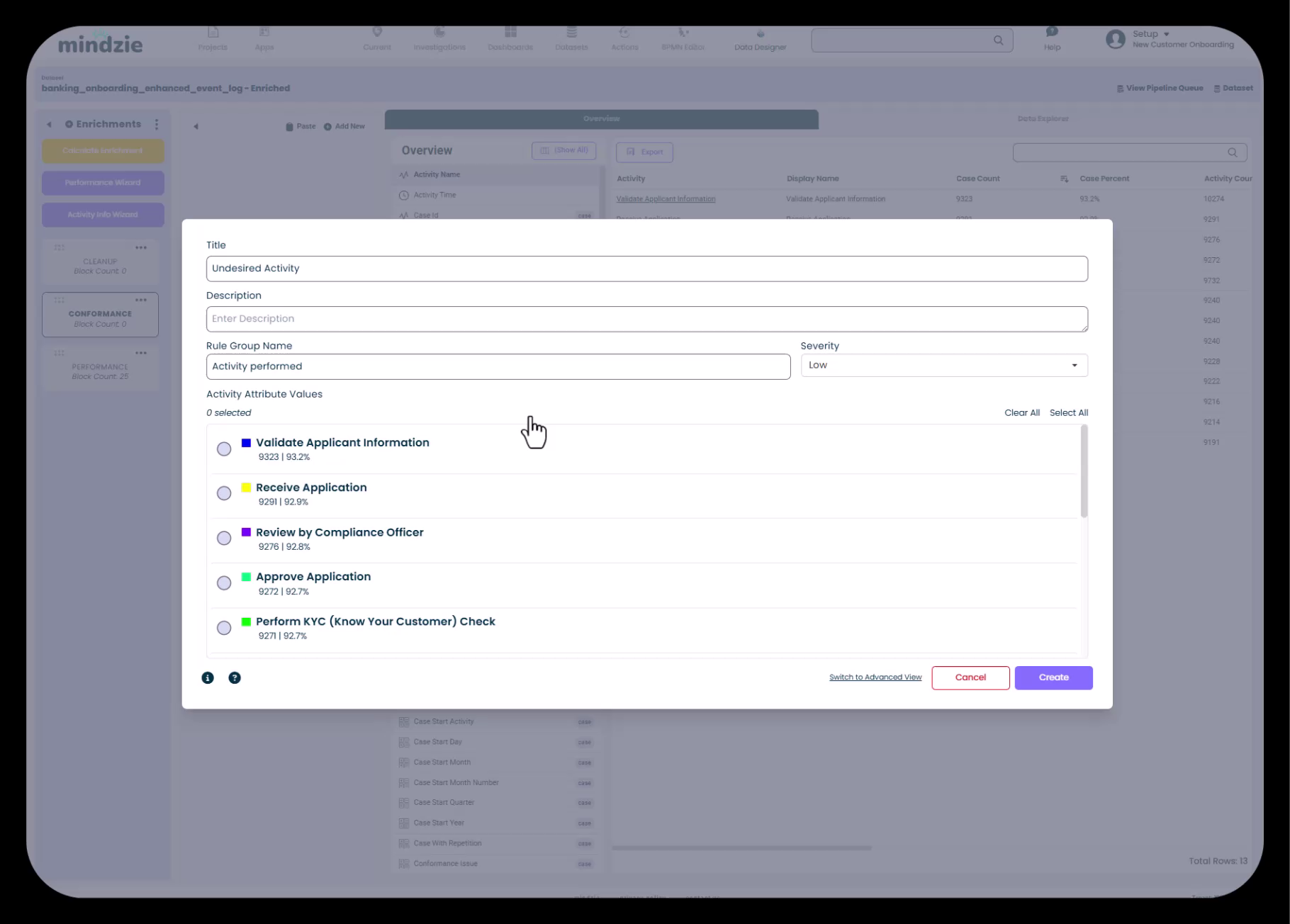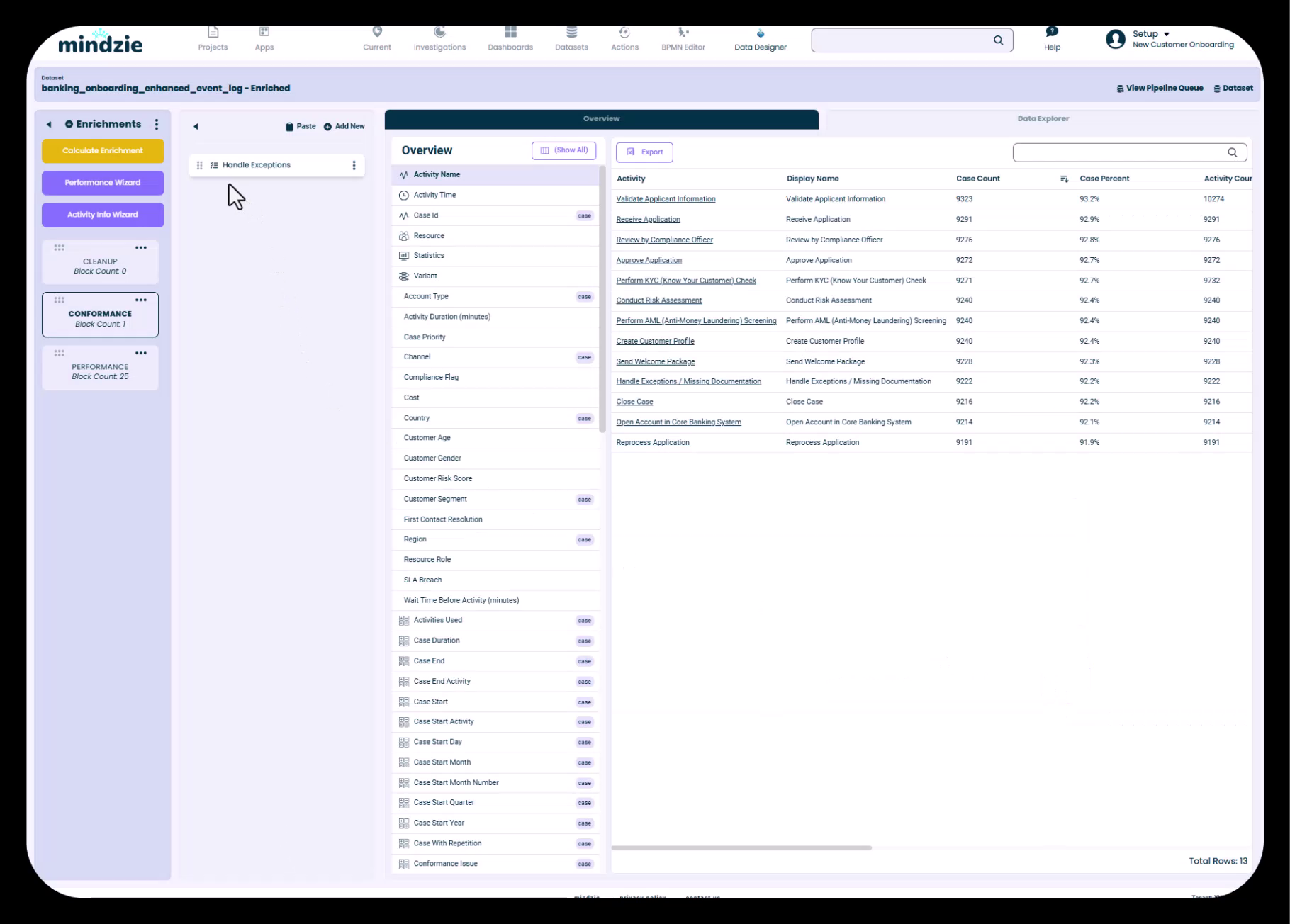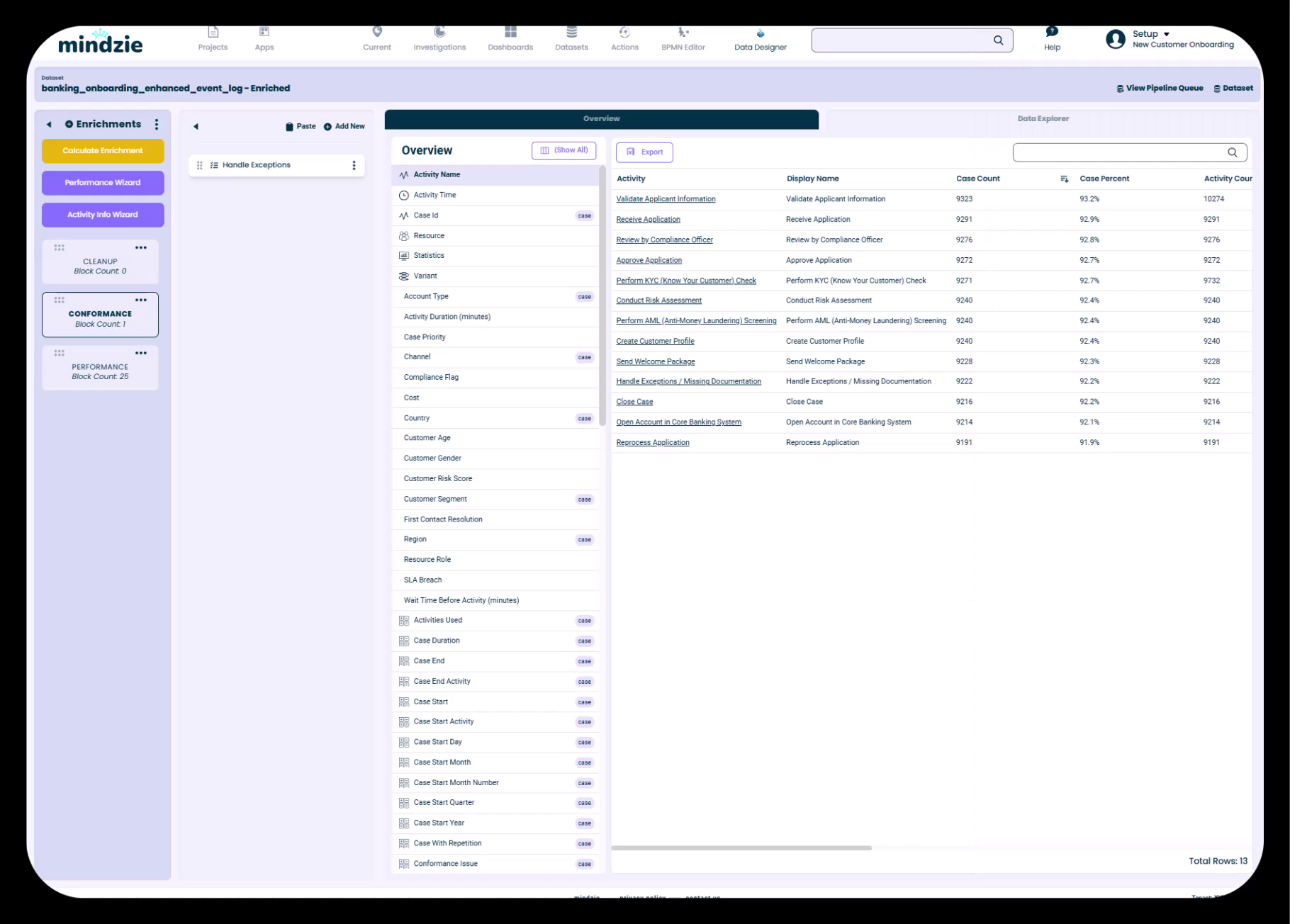Overview
Conformance checking is a critical component of process mining that helps organizations identify when their actual process execution deviates from expected or desired behavior. mindzie studio uses rule-based conformance to flag process violations, allowing you to monitor compliance, identify exceptions, and enforce process standards across your organization.
This guide walks you through creating and implementing conformance rules in mindzie studio, including how to identify undesired activities, set severity levels, detect missing steps, flag activity order violations, and apply these rules to your enriched dataset.
What is Rule-Based Conformance?
Rule-based conformance in mindzie studio allows you to define specific conditions that represent either desired or undesired process behavior. Unlike model-based conformance (which compares execution to an idealized process model), rule-based conformance lets you create targeted checks for specific compliance concerns.
With rule-based conformance, you can:
- Flag undesired activities that should not occur in a well-executed process
- Identify mandatory activities that must appear in every case
- Detect wrong activity order when steps occur in an incorrect sequence
- Flag repeated activities that indicate rework or inefficiency
- Set severity levels to prioritize compliance issues (low, medium, high)
These conformance rules become enrichments that are added to your dataset, creating new attributes you can use for analysis, filtering, and dashboard metrics.
Prerequisites
Before creating conformance rules, you should have:
- A mindzie studio project with data already uploaded
- Familiarity with the log enrichment engine
- Understanding of your process activities and expected workflow
- Knowledge of which process behaviors represent compliance violations
Accessing the Conformance Enrichment Tools
Conformance rules are created within the log enrichment section of mindzie studio.
Step 1: Navigate to Log Enrichment
- Open your project in mindzie studio
- Click on Enrichments in the main navigation
- You'll see existing enrichment notebooks on the left sidebar
Step 2: Create or Use a Conformance Notebook
For organization purposes, it's helpful to group conformance rules together:
- Create a new enrichment notebook called "Conformance" (or use an existing one)
- This notebook will contain all your conformance rule blocks
- Click Add New to begin adding conformance enrichments

The enrichment library shows various types of enrichments you can add. Look for conformance-related options.
Creating Undesired Activity Rules
Undesired activities are process steps that indicate problems, exceptions, or deviations from the ideal workflow. Common examples include exception handling, reprocessing, rework loops, or manual interventions.
Step 1: Select Undesired Activity Enrichment
- Click Add New in your conformance notebook
- Browse or search for Undesired Activity in the enrichment library
- Select it to open the configuration dialog
Step 2: Configure the Rule

In the configuration dialog, you'll need to specify:
Title: Give your rule a descriptive name (e.g., "Handle Exceptions", "Reprocess Application")
Description (optional): Add context about why this activity is undesired
Rule Group Name: This categorizes the rule (default is "Activity performed")
Severity: Choose the severity level for this violation:
- Low: Minor issues that should be monitored but are not critical
- Medium: Notable violations that require attention
- High: Critical compliance issues that demand immediate action
Activity Attribute Values: Select which activities from your process should be flagged as undesired. The dialog shows all available activities from your dataset with case counts and percentages.
Step 3: Select Undesired Activities
From the list of activities, select the ones that represent undesired behavior. For example:
- Handle Exceptions / Missing Documentation
- Reprocess Application
- Manual Override
- Exception Handling
- Rework Required
You can select multiple activities if they all represent the same type of conformance issue.
Step 4: Set Severity Level
Choose an appropriate severity level based on the business impact:
- High: Activities that represent serious compliance violations (e.g., skipped approval steps, regulatory violations)
- Medium: Activities that indicate inefficiency or quality issues (e.g., exception handling, reprocessing)
- Low: Activities that are undesirable but not critical (e.g., minor rework)
Step 5: Create the Rule
Click Create to add the conformance rule block to your notebook.

You'll now see a new block in your conformance notebook labeled "Handle Exceptions" (or whatever you named it). The block shows the configuration and is ready to be calculated.
Additional Conformance Rule Types
mindzie studio supports several other types of conformance rules beyond undesired activities:
Mandatory Activities
Use this rule type to identify cases where required activities are missing.
Use cases:
- Ensuring all cases include approval steps
- Verifying required documentation checks occurred
- Confirming compliance activities were completed
Configuration:
- Select which activities must appear in every case
- Set severity level for missing mandatory activities
- Cases without these activities will be flagged
Wrong Activity Order
Detect when activities occur in an incorrect sequence.
Use cases:
- Flagging approvals that happen before reviews
- Identifying payments processed before authorization
- Detecting steps that skip required predecessors
Configuration:
- Define the expected sequence of activities
- Specify which ordering violations to flag
- Set severity based on compliance impact
Repeated Activities
Identify cases where activities occur more than once, indicating rework or loops.
Use cases:
- Detecting rework and quality issues
- Identifying inefficient process loops
- Flagging repeated approvals or reviews
Configuration:
- Select activities that should only occur once
- Set threshold for how many repetitions trigger the flag
- Assign severity level
Calculating Conformance Enrichments
After creating your conformance rules, you must execute the data pipeline to apply them to your dataset.
Step 1: Calculate Enrichments
- Click the Calculate Enrichments button at the top of the enrichment section
- mindzie will execute the data pipeline and apply all conformance rules
- This process takes your original dataset and creates an enriched dataset with new conformance attributes
Step 2: Wait for Processing
The calculation time depends on your dataset size. You'll see a loading indicator while the enrichment is being processed.

Step 3: Verify Enrichment Completion
Once processing completes, your enriched dataset will be updated with new conformance attributes that you can use in analysis and dashboards.
Viewing Conformance Attributes in Your Dataset
After calculating conformance enrichments, new attributes are added to your enriched dataset.
Accessing the Data Overview
- Click on Datasets in the main navigation
- Select your enriched dataset (not the original dataset)
- Click on the Overview tab
Finding Conformance Attributes
Scroll through the attribute list to find your conformance enrichments. They typically appear with special icons indicating they are enriched attributes created by mindzie.
Look for attributes with names matching your conformance rules:
- Conformance Issue - A flag indicating whether any conformance violation occurred
- Compliance Flag - Specific flags for each rule type
- Individual rule names (e.g., "Handle Exceptions", "Missing Approval")
These attributes can now be used in:
- Filters to isolate conformance violations
- Calculators to count or analyze violations
- Dashboards to display compliance metrics
- Root cause analysis to identify factors contributing to violations
Using Conformance Attributes in Analysis
Once conformance attributes are created, you can leverage them throughout mindzie studio:
Create Compliance Dashboards
- Add KPIs showing percentage of cases with conformance issues
- Display trend charts showing conformance over time
- Break down violations by severity level
- Show top conformance issues by frequency
Filter Cases for Investigation
- Use filters to show only cases with high-severity violations
- Isolate cases with specific conformance issues
- Analyze process maps filtered to conformance violations
- Export lists of non-compliant cases for remediation
Perform Root Cause Analysis
- Investigate what factors correlate with conformance violations
- Identify departments, resources, or case types with higher violation rates
- Understand environmental factors contributing to non-compliance
Monitor Continuous Compliance
- Set up dashboards for ongoing monitoring
- Track compliance metrics as new data is loaded
- Alert stakeholders when violation rates exceed thresholds
Best Practices for Conformance Rules
Start with High-Impact Rules
Focus first on conformance rules that address the most critical compliance concerns or business risks. You can always add more detailed rules later.
Use Appropriate Severity Levels
- High: Reserve for serious compliance violations, regulatory issues, or high-risk activities
- Medium: Use for quality issues, inefficiencies, or process deviations that need attention
- Low: Apply to minor issues that should be monitored but aren't urgent
Organize Rules into Notebooks
Create separate enrichment notebooks for different types of conformance:
- Regulatory compliance rules
- Quality control rules
- Efficiency and performance rules
- Business policy rules
Document Your Rules
Use the description field to explain why an activity is undesired or why a rule was created. This helps other analysts understand the compliance framework.
Review and Refine Rules Regularly
As your process evolves, review conformance rules to ensure they remain relevant:
- Remove rules that no longer apply
- Update severity levels based on changing business priorities
- Add new rules as new compliance requirements emerge
Combine Multiple Rule Types
Use a combination of undesired activities, mandatory activities, and wrong order rules to create comprehensive compliance monitoring.
Common Use Cases
Financial Services Compliance
- Flag missing KYC (Know Your Customer) checks
- Detect unauthorized approvals
- Identify missing anti-money laundering reviews
- Track exceptions to standard procedures
Healthcare Process Compliance
- Ensure required patient consent activities
- Flag missing documentation steps
- Detect out-of-sequence treatment activities
- Monitor compliance with clinical protocols
Manufacturing Quality Control
- Identify skipped inspection steps
- Flag rework and reprocessing activities
- Detect missing quality checks
- Monitor deviation from standard operating procedures
Order-to-Cash Processes
- Ensure credit checks occur before fulfillment
- Flag shipments without proper authorization
- Detect missing invoice approvals
- Identify exception handling in payment processing
Troubleshooting
Conformance Attributes Not Appearing
If your conformance attributes don't appear after calculation:
- Verify you clicked "Calculate Enrichments" after creating rules
- Check that the calculation completed successfully (no error messages)
- Ensure you're viewing the enriched dataset, not the original dataset
- Refresh the data overview page
All Cases Flagged as Violations
If every case shows conformance violations:
- Review your rule configuration to ensure the logic is correct
- Check that you selected the right activities
- Verify the rule type matches your intention (e.g., mandatory vs. undesired)
Rules Not Detecting Expected Violations
If known violations aren't being flagged:
- Confirm activity names match exactly (case-sensitive)
- Check that the rule severity is set appropriately
- Verify the enrichment calculation completed
- Test with a simple rule first to confirm the system is working
Related Topics
- Mastering the Log Enrichment Engine - Learn about other types of enrichments you can create
- Creating Analysis with Filters and Calculators - Use conformance attributes in your analysis
- Publishing Metrics from Notebooks to Dashboards - Display conformance KPIs to end users
- Working with Root Cause Analysis - Investigate factors contributing to conformance violations
Conformance rules are powerful tools for ensuring your processes operate within expected parameters. By systematically flagging deviations, you can maintain process quality, ensure regulatory compliance, and drive continuous improvement across your organization.